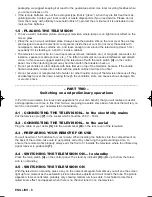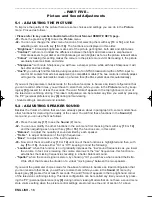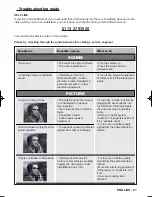
ENGLISH - 18
• AERIAL SOCKET [O]
This socket is on the rear television cover.
- It is used for the INPUT of the RF signal to the television.
- You can connect the following equipment to it: a)- The plug of your aerial; b)- Videorecorder.
• SCART 1 [N] and SCART 2# [O] PERITELEVISION SOCKETS
These sockets are on the rear television cover.
- They are used for the OUTPUT/ INPUT of the sound/video signal from and to the television.
- You can connect the following equipment to them: a)- Videorecorder; b)- Video camera; c)- Console
for video games; d)- Digital decoder for satellite; e)- Set Top Box for Internet; f) DVD player (and so on).
6.3 - B) SELECT THE CORRECT SCART OR AV CHANNEL
Once you have connected the equipment with their cables, to receive the sound/video signal on the
screen you have to indicate to the television which specific socket you have connected the equipment
to. The 3 choices described below can also be made by pressing key [23] on the remote repeatedly
until you see the acronym corresponding to the socket to which the equipment is connected, according
to the following.
• Choose the “AV-1” mode to see the signal coming from the SCART 1 [N] SOCKET or from the
VIDEO# [G] and AUDIO L/R# [H and I] CINCH SOCKETS.
— Note: In models where the front sockets are on the same AV channel as the SCART 1 socket, choo-
sing "AV-1" selects both SCART 1 and front CINCH inputs.
–– Note: Seeing as SCART 1 [N] peritelevision socket is also enabled to receive an RGB video signal,
if the external equipment has a video signal of this kind, you must make an additional choice in the
Set-up sub menu as follows:
• Please refer to key numbers illustrated on the front fold-out REMOTE KEYS page.
-01- Press key [9] to see the Main Settings menu.
-02- Press key [14] to scroll the menu until you reach the “Set-up” function and confirm your choice by
pressing key [15]: the Set-up menu appears on the screen.
-03- Press key [14] to scroll the menu until you reach the “AV1” function and choose option “RGB” with
key [15 or 16]. If the external equipment is sending a normal video signal to the socket then
choose the option “CVBS” with key [15 or 16].
• Choose the “AV-2”# mode to see the signal coming from the SCART 2# [N]
SOCKET
In some models the front sockets are on a separate AV channel, so it will be "AV-2".
For the remaining sockets the settings and optional choices must be made in other ways.
Here is what you have to do:
• With key [13 or 14] choose a programme between 0 and 99 to view the signal coming from the
AERIAL SOCKET [M]. Alternatively you can tap in the number wanted on the numerical keypad
[21].
–– Note: If you have to connect a video recorder to this socket, to see the picture on the screen you
will have to tune and store the sound/video signal as described in paragraph 4.2 - MANUALLY FIND-
ING AND STORING STATIONS. In this case set number “0” in the “Programme” function and number
“36” (or the number specified in the video recorder instruction booklet) in the “Channel” function.
• SOCKET FOR HEADPHONES [L]: when you connect headphones to this socket, sound is no
longer heard from the television speakers but sent only through the headphones. This means that
the possible headphone sound settings are the same as those made for the television loudspeaker
sound (see paragraph 5.2 - ADJUSTING SPEAKER SOUND).
Testo del man. SWING (UK) 14-10-2002 9:41 Pagina 18







































